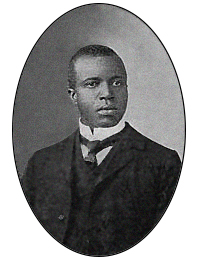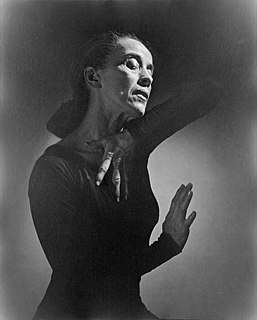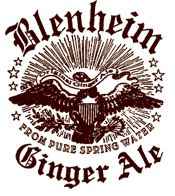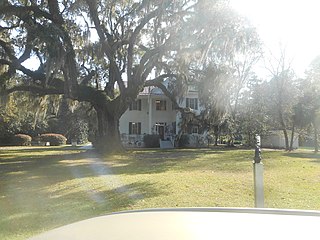
Scott Joplin was an American composer and pianist. Because of the fame achieved for his ragtime compositions, he was dubbed the "King of Ragtime." During his brief career, he wrote over 40 original ragtime pieces, one ragtime ballet, and two operas. One of his first and most popular pieces, the Maple Leaf Rag, became the genre's first and most influential hit, later being recognized as the archetypal rag. Joplin considered ragtime to be a form of classical music and largely disdained the practice of ragtime such as that in honky tonk.

Charleston is the largest city in the U.S. state of South Carolina, the county seat of Charleston County, and the principal city in the Charleston–North Charleston metropolitan area. The city lies just south of the geographical midpoint of South Carolina's coastline on Charleston Harbor, an inlet of the Atlantic Ocean formed by the confluence of the Ashley, Cooper, and Wando rivers. Charleston had a population of 150,277 as of the 2020 U.S. Census. The 2020 population of the Charleston metropolitan area, comprising Berkeley, Charleston, and Dorchester counties, was 799,636 residents, the third-largest in the state and the 74th-largest metropolitan statistical area in the United States.

Georgetown is the third oldest town in the U.S. state of South Carolina and the county seat of Georgetown County, in the Lowcountry. As of the 2010 census it had a population of 9,163. Located on Winyah Bay at the confluence of the Black, Great Pee Dee, Waccamaw, and Sampit rivers, Georgetown is the second largest seaport in South Carolina, handling over 960,000 tons of materials a year, while Charleston is the largest.

Martha Graham was an American modern dancer and choreographer. Her style, the Graham technique, reshaped American dance and is still taught worldwide.

The "Maple Leaf Rag" is an early ragtime musical composition for piano composed by Scott Joplin. It was one of Joplin's early works, and became the model for ragtime compositions by subsequent composers. It is one of the most famous of all ragtime pieces. As a result, Joplin became dubbed the "King of Ragtime" by his contemporaries. The piece gave Joplin a steady if unspectacular income for the rest of his life.

Blenheim Ginger Ale is a ginger ale bottled by Blenheim Bottlers in Hamer, Dillon County, South Carolina, but was originally bottled in Blenheim, Marlboro County, South Carolina. It has deep roots in the Pee Dee region of South Carolina, as it was created by a local doctor in the 1890s by mixing Jamaica ginger and sugar with local mineral waters and dispensed as a tonic for dyspepsia.

Keith Edward Acton is a Canadian former professional ice hockey centre who played 15 seasons in the National Hockey League (NHL), with the Montreal Canadiens, Minnesota North Stars, Edmonton Oilers, Philadelphia Flyers, Washington Capitals and New York Islanders between 1980 and 1994. In his NHL coaching career he has been an assistant coach with the Columbus Blue Jackets, the Philadelphia Flyers, the New York Rangers, the Toronto Maple Leafs and most recently the Edmonton Oilers, who released Acton and fellow assistant Craig Ramsay on June 4, 2015.

Drayton Hall is an 18th-century plantation located on the Ashley River about 15 miles (24 km) northwest of Charleston, South Carolina, and directly across the Ashley River from North Charleston, west of the Ashley in the Lowcountry. An example of Palladian architecture in North America and the only plantation house on the Ashley River to survive intact through both the Revolutionary and Civil wars, it is a National Historic Landmark.
Camellia sinensis, the source of tea leaves and buds, can be grown in warmer parts of the United States. Commercial cultivation has been tried at various times and locations since the 1700s, but tea has remained a niche crop and has never been cultivated widely in the US. As of 2020, the US mainland has one relatively large plantation with full mechanization in Charleston, South Carolina, and many small commercial tea gardens that pick tea by hand. Some growers feel that tea production is not viable without some mechanization, but there is evidence that unmechanized tea production is viable, albeit with lower net profit margins. Most domestically grown teas are available through mail order and online purchases.

The 1938 South Carolina gubernatorial election was held on November 8, 1938 to select the governor of the state of South Carolina. Burnet Rhett Maybank, Mayor of Charleston, South Carolina, won the contested Democratic primary and defeated Republican Joseph Augustis Tolbert in the general election becoming the 99th governor of South Carolina.

Duncan Clinch Heyward was the 88th Governor of South Carolina from January 20, 1903, to January 15, 1907.

William Henry Gist was the 68th Governor of South Carolina from 1858 to 1860 and a leader of the secession movement in South Carolina. He was one of the signers of the Ordinance of Secession on December 20, 1860, which effectively launched the Confederacy.

Arnoldus Vanderhorst was a general of the South Carolina militia during the Revolutionary War and the 38th Governor of South Carolina from 1794 to 1796.
Terese Capucilli, acclaimed interpreter of the roles originally performed by Martha Graham, is one of the last generation of dancers to be coached and directed by Graham herself. A principal dancer with the Martha Graham Dance Company for twenty-six years, she became associate artistic director in 1997 and from 2002 to 2005 served as artistic director, with Christine Dakin, seeing the organization and its dancers through the rebirth of the company. A torchbearer and driving force of Graham's work for nearly three decades, she is now Artistic Director Laureate.

Medway or the Medway Plantation is a plantation in Mount Holly, South Carolina within Berkeley County, South Carolina. It is about 2 mi (3.2 km) east of U.S. Route 52 from the unincorporated community of Mount Holly, which is directly north of Goose Creek, South Carolina. It was named to the National Register of Historic Places on July 16, 1970.

The Wedge Plantation, which is also known as The Wedge or the William Lucas House, is a plantation about 5 mi (8 km) east of McClellanville in Charleston County, South Carolina. The plantation is a wedge-shaped property between the Harrietta Plantation and the Fairfield Plantation. The plantation house was built around 1830. It is located off US Highway 17 near the Santee River. It was named to the National Register of Historic Places on September 18, 1975.

The Charleston Tea Garden is located about twenty miles south of Charleston, South Carolina on Wadmalaw Island. Owned by the Bigelow Tea Company, it grows the tea sold under the brand name American Classic Tea and Charleston Tea Garden from the Camellia sinensis plant. Every year they used to host the First Flush Festival celebrating the beginning of the harvest season.

Point South is an unincorporated community located in Jasper County, South Carolina, United States near the borders of Beaufort and Hampton counties and close to the geographic center of the Lowcountry. It is centered on the junction of Interstate 95 and U.S. Route 17. It was developed partially by the Sea Pines Company in the 1960s and 1970s to help attract visitors to the Hilton Head region.
Maple Leaf Rag is a storyless Martha Graham ballet set to ragtime compositions by Scott Joplin. The work premiered on October 2, 1990 at New York City Center with costumes by Calvin Klein and lighting by David Finley. Chris Landriau arranged the music and played piano at the debut. The dance is a jubilant self-parody and an homage, of sorts, to Graham's mentor and musical director, Louis Horst, who would play the rag for her whenever she fell into a creative slump. Graham was 96 when she created Maple Leaf Rag; it is her last completed dance. In 1991, she began another work, The Eyes of the Goddess, but it was unfinished at the time of her death.

















